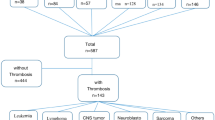Abstract
Background
Intravenous ports are widely used for oncology patients. However, catheter fractures may lead to the need for re-intervention. We aimed to identify the risk factors associated with catheter fractures.
Methods
Between January 1 and December 31, 2006, we retrospectively reviewed the clinical data and plain chest films of 1,505 patients implanted with an intravenous port at Chang Gung Memorial Hospital. Different vascular sites were compared using the chi-square or Fisher’s exact test for categorical variables, and the t test was used for continuous variables with normal distribution; P < 0.05 was considered statistically significant.
Results
There were 59 and 1,448 procedures in the fracture and non-fracture groups, respectively. Monovariate analysis revealed that the risk factors for catheter fracture were as follows: large angle (P < 0.0001), female gender (P < 0.0008), subclavian route (P < 0.0001), and port type Arrow French (Fr.) 8.1 (P < 0.0001). Because these risk factors showed no interaction effects, they were all considered independent risk factors. When all factors were considered together, all risk factors, except angle and age, retained their statistical significance.
Conclusions
Most catheter fractures were caused by material weakness. If catheter fracture is confirmed, further intervention for port and catheter removal is recommended. Female gender, intravenous port implantation via the subclavian route, and the Arrow Fr. 8.1 port were found to be risk factors. Patients with these risk factors should be monitored closely to avoid catheter fractures.


Similar content being viewed by others
References
Hengartner H, Berger C, Nadal D et al (2004) Port-A-Cath infections in children with cancer. Eur J Cancer 40:2452–2458
Simon A, Bode U, Beutel K (2006) Diagnosis and treatment of catheter-related infections in pediatric oncology, an update. Clin Microbiol Infect 12:606–620
Niederhuber JE, Ensminger W, Gyves JW et al (1982) Totally implanted venous and arterial access system to replace external catheters in cancer treatment. Surgery 92:706–712
Kock HJ, Pietsch M, Krause U et al (1998) Implantable vascular access system. Experience in 1500 patients with totally implanted central venous port system. World J Surg 22:12–16. doi:10.1007/s002689900342
Wu JR, Hsu JH, Chang TT et al (2002) Nonsurgical percutaneous retrieval of dislodged port-A catheters from pulmonary artery in children. Jpn Heart J 43:295–300
Coit DG, Turnbull AD (1988) A safe technique for placement of implantable vascular access devices in patients with thrombocytopenia. Surg Gynecol Oncol 14:63–68
Moureau N, Poole S, Murdock MA et al (2002) Central venous catheters in home infusion care: outcomes analysis in 50, 470 patients. J Vasc Interv Radiol 13:1009–1016
Liu JC, Tseng HS, Chen CY et al (2004) Percutaneous retrieval of 20 centrally dislodged port-A catheter fragments. Clin Imaging 28:223–229
Grabenwoeger F, Bardach G, Dock W et al (1988) Percutaneous extraction of centrally embolized foreign bodies: a report of 16 cases. Br J Radiol 61:1014–1018
Fisher RG, Ferreyro R (1978) Evaluation of current techniques for nonsurgical removal of intravascular iatrogenic foreign bodies. AJR Am J Roentgenol 130:541–548
Coles CE, Whitear WP, LeVay JH (1998) Spontaneous fracture and embolization of a central venous catheter: prevention and early detection. Clin Oncol 10:412–414
Teichgräber UK, Gebauer B, Benter T et al (2003) Central venous access catheters: radiological management of complications. Cardiovasc Intervent Radiol 26:321–333
Bloomfield DA (1971) Techniques of nonsurgical retrieval of iatrogenic foreign bodies from the heart. Am J Cardiol 27:538–545
Aitken DR, Minton JP (1984) The “pinch-off sign”: a warning of impending problems with permanent subclavian catheters. Am J Surg 148:633–636
Yu SY, Lee CH, Ko PJ et al (2009) Use of stone basket for removal of fractured totally implanted central venous device catheters. Formos J Surg 42:87–94
Acknowledgments
The authors are grateful to Chee-Jen Chang, PhD, of the Clinical Informatics and Medical Statistics Research Center, Chang Gung University, Taoyuan, Taiwan, who helped us with the statistical analysis of the clinical data. This study was approved by the Institutional Review Board of Chang Gung Medical Foundation on June 17, 2010. The IRB approval number is 99-1558B.
Author information
Authors and Affiliations
Corresponding author
Additional information
Ching-Yang Wu and Jui-Ying Fu contributed equally to this article.
Rights and permissions
About this article
Cite this article
Wu, CY., Fu, JY., Feng, PH. et al. Catheter Fracture of Intravenous Ports and its Management. World J Surg 35, 2403–2410 (2011). https://doi.org/10.1007/s00268-011-1200-x
Published:
Issue Date:
DOI: https://doi.org/10.1007/s00268-011-1200-x




